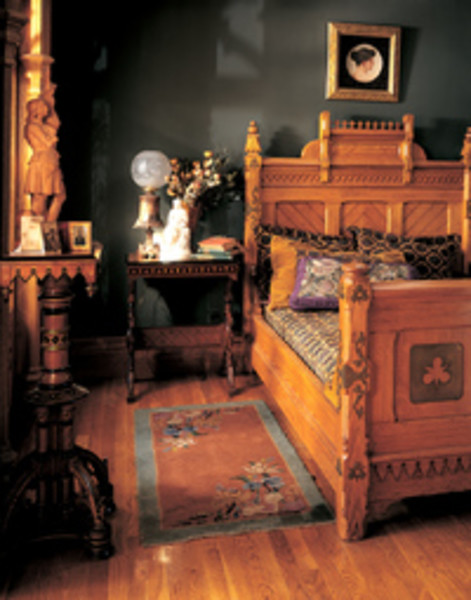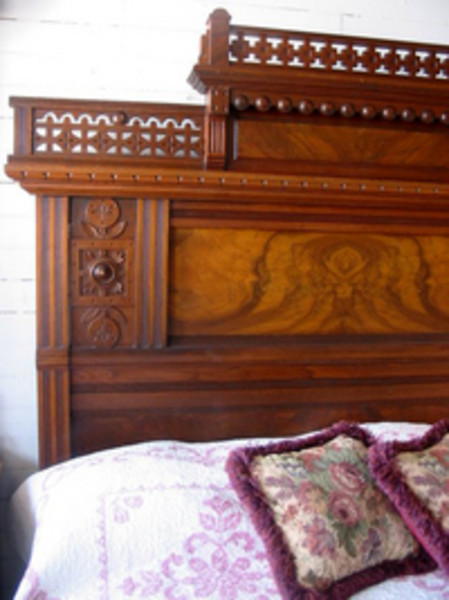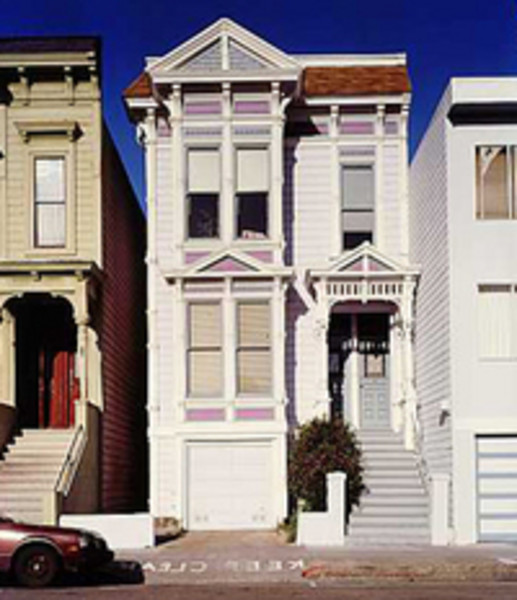
The chestnut bed with ornamental strapwork was made by Kimble & Cabus, one of the foremost producers of Modern Gothic, or Eastlake-style, furniture.
Before the word was misapplied to all manner of ornament, Eastlake was the most popular variant of the Aesthetic Movement in America: bold and muscular, woody, neo-Gothic. “Eastlake” is often a label applied to dark furniture of the late-Victorian period. But for those interested in the decorative arts of the 1870s and 1880s, including those with houses in the Stick, Queen Anne, and Shingle styles, Eastlake is worth getting to know.
It began in England during the 1860s, when rebels including William Morris and Bruce Talbert helped usher in the so-called Aesthetic Movement, a reaction to the carved rosewood furniture and garish coloring of the mid-Victorian period. These neo-medievalists looked back to pre-industrial artisanry. They championed subdued, natural colors and simpler furniture, and preached for flat, stylized ornament in carving and on walls and textiles.

The style came to America by the 1870s. By then, Charles Locke Eastlake (1836–1906) was a household name, owing to his popular book Hints on Household Taste. American writers including Harriet Spofford and Clarence Cook, calling the style Modern Gothic, advanced Eastlake’s ideas further. Although Eastlake is often considered a furniture type, it also refers to interior decorating and even architecture.
The Eastlake style hit its apogee in San Francisco, then a frontier city with an abundant supply of redwood that could be turned, chamfered, and incised. (Mr. Eastlake scolded the citizens of San Francisco in a newspaper article, disavowing any responsibility for the flamboyant architectural style that now bore his name.)

Although it’s safe to say that the Eastlake style, taken nationwide, was the most popular variant of the Aesthetic Movement in America, it was not the only one. Tiffany and Associated Artists (including the textile designer Candace Wheeler) produced interiors that owed much more to the English Aesthetic Movement. Such rooms were highly decorated, often with Arabic or other exotic touches. It was wall decoration, glass, color, and textiles that defined a Tiffany (Aesthetic) room, not the furniture.
By contrast, Eastlake interiors were decorated with wood—in dadoes, beamed and coffered ceilings, massive bracketed mantels with overhoods and shelves, and heavily corniced, neo-Gothic bookcases with incising. It might be useful to think of Aesthetic Movement interiors as tending toward the feminine, while Eastlake is undeniably masculine.

This Modern Gothic interior as close to quintessential Eastlake as they come: muscular use of wood, bracing and diagonals, chamfers, stylized ornament, and medieval motifs.
Hallmarks of Eastlake Influence
• Wood panels, wainscot, boards, ceilings, moldings
• Abstract ornamentation of woodwork and furniture, including chamfered corners, beading, incising, and diagonals
• Modern Gothic (medieval revival) details, including ball-and-spindle spandrels, carved brackets, sawtooth trim, attenuated and pointed elements
• Stylized ornament, as with abstracted flower forms and geometrics
• Strapwork in metal
• Polychromed detailing
Recommended Reading on Gothic Interiors
Hints on Household Taste
By Charles L. Eastlake (Dover, 1986)
Reprint of the 1868–1872 book by the Aesthetic Movement tastemaker and critic.

The Aesthetic Movement
By Lionel Lambourne (Phaidon, 1996)
The English art movement of the 1880s and 1890s that had such great impact even in America. The book is monumental but very readable, starting with the Japonisme fad and moving on to Whistler, Ruskin, Oscar Wilde, Godwin, even Mackintosh. Lavish.
America’s Painted Ladies
By Elizabeth Pomada (Studio, 1994)
A beautifully illustrated book in the Painted Ladies series, including houses of the Eastlake/Stick Style in San Francisco and elsewhere in the country.
See also the writings of 19th-century critic and architectural historian John Ruskin: The Seven Lamps of Architecture, The Stones of Venice (includes the famous essay “The Nature of Gothic”), and On Art and Life, as well as the 19th-century work of Bruce Talbert, E.W. Godwin, Philip Webb, and William Morris.







